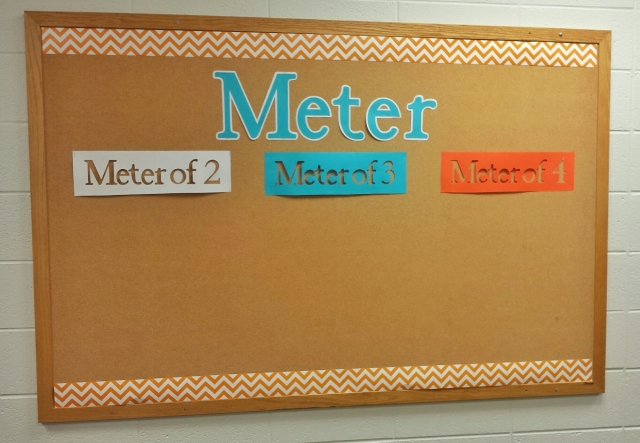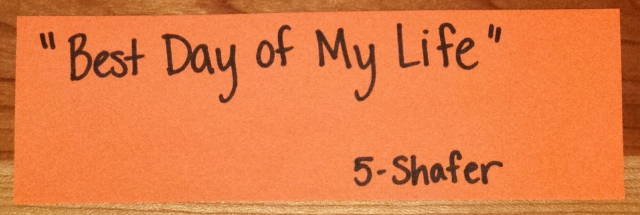The Meter Wall is an engaging, educational, fun, and easy way to learn and assess meter.
Today, I am participating in the “What’s on your Wall?” linkup with some other blogs. We are all going to write about something that’s on our wall at school. I chose to feature my Meter Wall because it is really cool and fun and I love it! I hope you get some good ideas and maybe even get inspired to start a Meter Wall of your own!
I love my Meter Wall! It is a place for students to contribute to the music classroom, connect music class with the outside world, and apply music skills. I sneak in a little formative assessment when they’re not looking. Some students even choose to make it a friendly competition!
Here’s how the Meter Wall works.
At the beginning of the year, the Meter Wall is a bulletin board with the word “Meter” and three large cards in different colors: “Meter of 2,” “Meter of 3,” and “Meter of 4.” (Note: I ended up having to add cards for meters in 5, 6, and 7 last year because we encountered songs with those meters!)
Older grades begin using the Meter Wall immediately in the fall when they review meter. I allow students to suggest any song in the history of the world. If the song is not something I’ve taught them, I write down the title and artist and look up the song later during my prep time. If the song passes my strict school-appropriateness check (and I am strict), I play it for the class during their next session. I will either play the free preview track on the iTunes store or find the full track on YouTube.
Now for the magic. While the song is playing, students have to discover the meter themselves so we can add the song to the Meter Wall.
First, they show the steady beat by patting it on their legs. Then, after the beat is solid, they try to find the strong beats. They pat their legs on the strong beats and clap on the weak beats. This pat-clap pattern makes it very obvious who has it (formative assessment), makes it easy for the students to count the number of beats in a group (kinesthetic learning), and helps students who have not quite figured it out (social learning).
Once most students are correctly pat-clapping the meter, I ask them to count out loud. They say “one” on every strong beat and continue counting until the next strong beat, when they start over at “one.” I wait until the whole class is counting out loud together. Then I ask what the meter is. Most students can get it right the first time when we follow this procedure. Many get upset if I stop the music too early, so I let it play out if there’s time. While the song finishes, I write the song title and the class’s name on a piece of paper to match the meter wall colors (white for meter of 2, blue for meter of 3, orange for meter of 4).
I take the piece of paper with the song name and staple it to the Meter Wall bulletin board underneath its meter category. As the lists grow, it’s really interesting to see which meter has the most songs and which meter has the fewest. For students with a competitive streak, I allow them to count how many songs were contributed by each class. This worked out just fine because the ones who cared the most tended to be in the lead because they were suggesting more songs. The classes with fewer songs on the Meter Wall tended to be less interested and therefore not hurt that they weren’t in the lead.
Even students as young as first grade have had success with this activity! It’s a fun way for kids to see themselves represented in music class by bringing in their music. It helps me keep my finger on the pulse of what is popular among my students. It keeps students interested in music class when I teach them a new song, because they always want to add it to the Meter Wall. Students can continue the practice of finding the meter of a song when they are listening to music outside of class, bringing what they are learning into the real world. And it’s an engaging method of reviewing and assessing an important musical skill.
Thanks for reading! So, which meters do you think are the most common? Post your answers in the comments section below. I’ll let you know what my students and I found in a later post!
Click below to visit some of the other posts in this linkup!





This is such a great idea! I bet it really gets kids thinking outside of class too. I love those kinds of connections! Thanks for linking up! -Tracy
LikeLiked by 1 person
Thanks! Yes, it’s cool to see the connections kids make. And they introduce me to some new music, not always pop!
LikeLike
This is such a fabulous idea! I always have such a hard time remembering to talk about meter, and I feel like this is something students would love and thus it would keep me accountable to discussing it more!
LikeLiked by 1 person
Yes, the kids love it! There were a few times last year where they requested it so much I got a little sick of it. But that’s a good thing! 🙂
LikeLike
Thank you for contributing to the September Music Education Blog Carnival! http://musicwithmrsdennis.blogspot.com/2015/09/music-education-blog-carnival-september.html
LikeLike